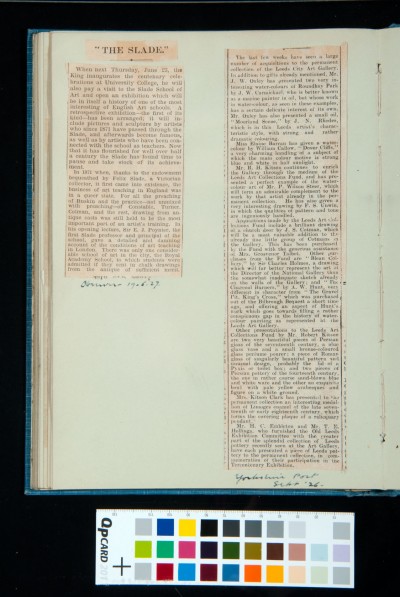Cotmania. Vol. I. 1926-7
Archive: SDK Sydney Decimus Kitson Archive
Reference Number: SDK/1/2/1/1
Page: 29 verso
-
Description
"THE SLADE"
Press cuttings: The Observer on Slade School of Art; and The Yorkshire Post on Leeds Art Gallery acquisitions.
Date: 19.06.1927
-
Transcription
When next Thursday, June 23, the King inaugurates the centenary cele-brations at University College, he will also pay a visit to the Slade College of Art and open an exhibition which will be in itself a history of one of the most interesting of English Art schools. A retrospective exhibition - the first of its kind - has been arranged; it will include pictures and sculpture by artists who since 1871 have passed through the Slade, and afterwards become famous, as well as by artists who have been connected with the school as teachers. Now that it has flourished for well over half a century the Slade has found time to pause and take stock of its achievement.
In 1871 when, thanks to the endowment bequeathed by Felix Slade, a Victorian collector, it first came into existence, the business of art teaching in England was in a queer state. For all the preaching of Ruskin and the practice - not unmixed with preaching- of Constable, Turner, Cotman, and the rest, drawing from antique casts was still held to be the most important part of an artist's training. In his opening lecture, Sir E.J. Poynter, the first Slade professor and principal of the school, gave a detailed and damning account of the conditions of art teaching in London. There was only one considerable school of art in the city, the Royal Academy School, to which students were admitted if they sent in chalk drawings from the antique of sufficient merit. {Kitson notes:} Observer 19.6.27
The last few weeks have seen a large number of acquisitions to the permanent collection of the Leeds City Art Gallery. In addition to gifts already mentioned, Mr. J. W. Oxley has presented two very interesting watercolours of Roundhay Park by J.W. Carmichael, who is better known as a marine painter in oil, but whose work in water-colour, as seen in these examples, has a certain delicate interest of its own. Mr. Oxley has also presented a small oil, "Moorland Scene," by J. N. Rhodes, which is in this Leeds artist's characteristic style, with strong and rather dramatic colouring.
Miss Elaine Barran has given a water-colour by William Callow, "Dover Cliffs," a very charming handling of a subject of which the main colour motive is strong blue and white in half sunlight.
Mr. R. H. Kitson continues to enrich the Gallery through the medium of the Leeds Art Collections Fund, and has presented a perfect example of the watercolour art of Mr. P. Wilson Steer, which will form an admirable complement to the work by that artist already in the permanent collection. He has also given a very interesting drawing by F. S. Unwin, in which the qualities of pattern and tone are ingeniously handled.
Acquisitions made by the Leeds Art Collections Fund include a brilliant drawing of a church door by J.S. Cotman, which will be a most valuable addition to the already fine little group of Cotmans in the Gallery. This has been purchased by the Fund with the generous assistance of Mrs Grosvenor Talbot. Other purchases from the Fund are "Blean Colliery" by Sir Charles Holmes, a drawing which will far better represent the art of the Director of the National Gallery than the somewhat inadequate sketch already on the walls of the gallery; and "The Charcoal Burners," by A. W. Hunt, very different in character from "The Gravel Pit, King's Cross," which was purchased out of the Bilbrough Bequest a short time ago, and offering an aspect of Hunt's work which goes towards filling a rather conspicuous gap in the history of watercolour painting as represented at the Leeds Art Gallery.
Other presentations to the Leeds Art Collections Fund by Mr. Robert Kitson are two very beautiful pieces of Persian glass of the seventeenth century, a blue glass vase and a small bronze-coloured glass perfume pourer; a piece of Roman glass of singularly beautiful pattern and unusual design, probably the lid of a Pyxis or toilet box; and two pieces of Persian pottery of the fourteenth century, the one in rather coarse sand-blown blue and white ware and the other an exquisite bowl with pakle yellow arabesques and figure on a white ground.
Mrs. Kitson-Clark has presented to the permanent collection an interesting medal-lion of Limoges enamel of the late seventeenth or early eighteenth century, which forms the covering plaque of a relicquary (sic) pendant.
Mr. H. C. Embleton and Mr. T.P. Hollings, who furnished the Old Leeds Exhibition Committee with the greater part of the splendid collection of Leeds pottery to the permanent collection, in com-memoration of their participation in the Tercentenary Exhibition. {Kitson notes:} Yorkshire Post Sept '26.
